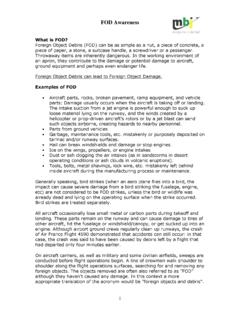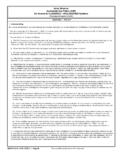Transcription of Airside Communication Manual - Sangster International Airport
1 Airside Communication Manual THIS DOCUMENT AND THE MATTERS CONTAINED HEREIN ARE privileged AND confidential AND REMAIN THE SOLE PROPERTY. OF MBJ AIRPORTS LTD. ANY OTHER DISTRIBUTION, COPYING OR DISCLOSURE IS STRICTLY PROHIBITED. Revision 1. May 2011. Table of Contents Communication One .. 3. Communication Systems Introduction to Communication .. 3. Communication 3. Elements of a Communication System .. 4. Barriers to Effective Communication .. 4. Communication in Civil Aviation .. 5. Communication 6. Phonetics Alpha Phonetics .. 6. Numeric Phonetics .. 7. Communication Two Worksheet .. 9. Communication Three .. 10. Standard Phraseology for Radio Contact ATC Phraseology .. 10. Standard Words and Phrases .. 11. Call Signs .. 12. 12. Guidance for Radio Contact .. 13. Crossing Runway .. 13. Aerodrome Environment .. 14. Aerodrome Geographical Data Definitions.
2 14. Aerodrome Geographical and Administrative Data .. 18. Sangster Runway .. 20. Calculation of Active Runway .. 21. Aerodrome Environment Three .. 22. Aerodrome Markings Runway and Threshold Markings .. 22. Taxiway Markings .. 23. Holding Point Markings .. 24. Visual Aids Denoting Restricted Use Area .. 24. Non Load Bearing Surfaces .. 25. 1. Revision 1. Airside Communication Manual May 2011. Aerodrome Environment Four .. 28. Aerodrome Lighting and Signals Approved Aeronautical Lights .. 28. Runway Threshold Lights .. 28. Runway End Lights .. 30. Runway Centerline and Touchdown Zone Lights .. 31. Stopway Lights .. 31. Taxiway Lights .. 31. Approach Lighting .. 32. Visual Approach Slope Indicator Systems .. 34. Aerodrome Beacon .. 35. Light Mountings .. 35. Light Intensity Control .. 35. Local Operation of Aerodrome Lighting .. 36.
3 Aerodrome Markings and Lighting .. 37. Aerodrome Environment Five .. 38. Objects within Aerodrome Objects Within Specified Areas .. 38. Objects to be Marked or Lit .. 38. Lighting of Objects .. 39. Visual Aids to Landing .. 42. Aerodrome Environment Six .. 43. Traffic on the Manoeuvring Area Movement on Manoeuvring Area .. 43. Signaling 43. ATC Light Signals .. 45. Aerodrome Operations Two .. 46. Vehicle Safety Safety Requirement for Vehicle and Equipment .. 46. Traffic of Persons and Vehicles on Aerodrome .. 47. 2. Revision 1. Airside Communication Manual May 2011. COMMUNICATIONS ONE. INTRODUCTION TO COMMUNICATIONS. General Communication is defined as, the transfer of information from one party to another and feedback confirming that the information has been received. You will note that only the successful transfer of information is called Communication .
4 If a person tries to pass information that is understand differently from the intent of the message then Communication has not taken place. In communicating, we must therefore seek to engage effective Communication an exercise which produces a situation in which both sender and receiver have the same understanding of the information transmitted. Effective Communication is absolutely necessary for safe and efficient operations within the manoeuvring area. Effective communications technique is an essential item, without which there can be no transfer of information, or at best only a partial transfer. We communicate in many ways, with words, pictures, body language (facial expressions, hand gestures, etc.). The more senses stimulated the more effective communications will be. Some means of Communication include: the spoken word the written word diagrams and pictures sound codes (Morse, etc.)
5 Signals (light). body language Communication Systems Technology affords Communication via communications systems. These are devices used for transmission and reception of information over long distances. Examples of these are: telephone television commercial radio Aeronautical Telecommunication System 3. Revision 1. Airside Communication Manual May 2011. Elements of a Communication System Communication is the sending of messages, which evokes responses. It involves the use of the five senses, mainly sight and hearing, and the three methods most often used are written, oral and visual. The basic elements of Communication are: (a) The sender/transmitter/source - originator of the information (b) The receiver - receives the information (c) The message the information (d) The channel/ transmission/link, the physical path via which the information is transferred (e) Feedback interpretation of the information TRANSMITTER Transmission Link or channel RECEIVER.
6 Information/Message Feedback Barriers to Effective Communications The ability to communicate with others is often taken for granted. What if there was a barrier (noise) to our efforts in trying to communicate? Throughout all these elements, interference exists, called noise. Noise is information, either literal (talking in the background) or psychological (thinking about chores at home), that interferes with the accurate reception of the Communication of the message, in other words it keeps a message from being understood and achieving its intended effect. Without noise, all messages would be communicated with sublime accuracy. But noise is always present. Communicating accurate messages involves minimizing both external and psychological noise. These barriers could take the form of: language differences speech difficulty unfamiliarity with codes or signals used noise ambiguity mind wandering distance stereotyping physical environment such as wind, etc.
7 4. Revision 1. Airside Communication Manual May 2011. Communication in Civil Aviation In Civil Aviation, we are concerned with two broad categories of Communication systems, namely the Cable System and the Radio (Wireless) System. The services associated with these systems are collectively referred to as the Aeronautical Telecommunication Service The Aeronautical Telecommunication Service is divided as follows: - 1. The Aeronautical Mobile Service (AMS) has to do with radio telecommunications between aircraft and Air Traffic Control (ATC). It makes it possible for aircraft to communicate with ATC and other ground-based agencies. 2. The Aeronautical Broadcast Service (ABS) has to do with the general broadcast of aeronautical information, for example, weather, runway in use, essential aerodrome conditions, etc. on specific broadcast frequencies from which interested parties may obtain the information.
8 3. The Aeronautical Radio Navigational Service (ARNS) has to do with radio navigational aids, such as Very High Frequency Omni-Directional Range (VOR), Non-Directional Radio Beacon (NDB), Instrument Landing System (ILS), Microwave Landing System, etc. 4. The Aeronautical Fixed Service (AFS) has to do with communications between aeronautical fixed stations on the surface, such as Air Traffic Control (ATC), Meteorological Office (MET), MBJ Operations vehicles on the aerodrome and Airline companies. The Aeronautical Fixed Telecommunication Network (AFTN) is used in the provision of this service. 5. Revision 1. Airside Communication Manual May 2011. COMMUNICATIONS TWO. ALPHA PHONETICS. It has been determined that the incidence of misunderstanding between pilots, aerodrome users and air traffic services personnel have been responsible for a number of dangerous situations.
9 The high safety and efficiency needs of aviation demands that due care and close attention is paid to verbal Communication . Air traffic control, because of occasional poor radio reception, unfamiliarity, accents etc. sometimes requires aviation personnel to spell names of locations or instruction, etc. The objective of the phonetic alpha/numeric is to standardize the way in which letters and numbers are enunciated in order to reduce misunderstanding between aviation personnel. Syllables to be emphasized are underlined: Letter Word Pronunciation A Alpha AL FAH. B Bravo BRAH VOH. C Charlie CHAR LEE or SHAR LEE. D Delta DELL TAH. E Echo ECK OH. F Foxtrot FOKS TROT. G Golf GOLF. H Hotel HOH TELL. I India IN DEE AH. J Juliet JEW LEE ETT. K Kilo KEY LOH. L Lima LEE MAH. M Mike MIKE. N November NO VEM BER. O Oscar OSS CAH. P Papa PAH PAH.
10 Q Quebec KEH BECK. R Romeo ROW ME OH. S Sierra SEE AIR RAH. T Tango TANG GO. U Uniform YOU NEE FORM or OO NEE FORM. V Victor VIK TAH. W Whiskey WISS KEY. X X-ray ECKS RAY. Y Yankee YANG KEY. Z Zulu ZOO LOO. 6. Revision 1. Airside Communication Manual May 2011. NUMERIC PHONETICS. When transmitting numbers, the syllables printed in capital letters are to be stressed. Numeral Pronunciation Element 0 ZE-RO. 1 WUN. 2 TOO. 3 TREE. 4 FOW-er 5 FIFE. 6 SIX. 7 SEV-en 8 AIT. 9 NIN-er Decimal DAY-SEE MAL. Hundred HUN-dred Thousand TOU-SAND. All numbers except whole hundreds, whole thousands, and combinations of thousands and whole hundreds shall be transmitted by pronouncing each digit separately. Whole hundreds and whole thousands shall be transmitted by pronouncing each digit in the number of hundreds or thousands followed by the word HUNDRED or THOUSAND as appropriate.










